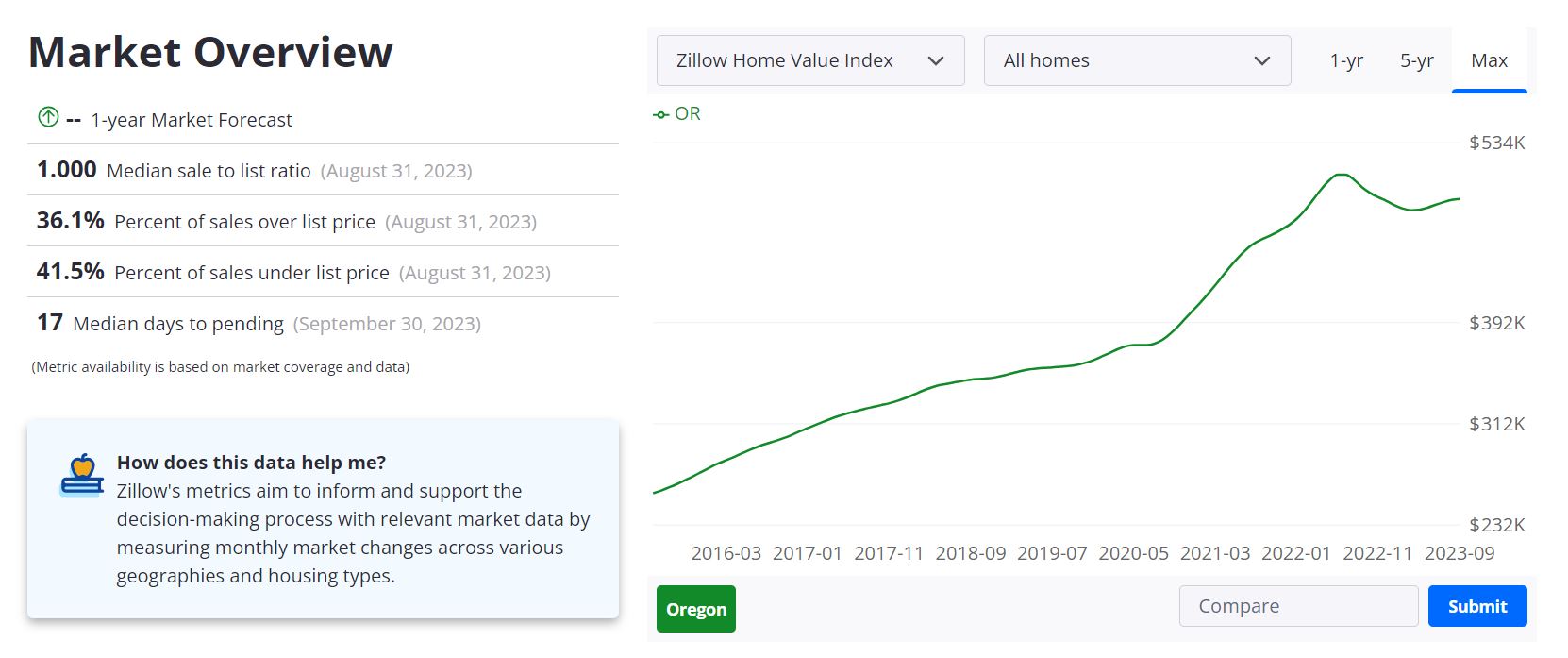The real estate market is a dynamic and ever-changing landscape that plays a crucial role in the overall economy. For potential homebuyers, sellers, and investors, staying informed about the current house prices and trends is essential for making well-informed decisions. In this blog post, we’ll delve into the recent trends and forecasts for Oregon’s housing market.
Oregon Housing Market Trends
What is the housing market like right now? According to the data from Redfin, in September 2023, home prices in Oregon were down 0.55% compared to last year, selling for a median price of $501,600. On average, the number of homes sold was down 22.3% year over year, and there were 3,897 homes sold in September this year, down 5,016 homes sold in September last year. The median days on the market was 29 days.
Oregon Housing Supply & Demand
Are there enough homes for sale to meet buyer demand? In September 2023, there were 15,035 homes for sale in Oregon, down 11.1% year over year. The number of newly listed homes was 4,219 and down 20.2% year over year. The average months of supply is 3 months, up 0 year over year.
How competitive is the market? In September 2023, 28.1% of homes in Oregon sold above list price, up 0.3 points year over year. There were only 37.3% of homes that had price drops, down from 39.0% of homes in September last year. There was a 99.0% sale-to-list price, down 0.054 points year over year.
Are Home Prices Dropping in 2023?
In 2023, the housing market in Oregon is experiencing a slight decline in home prices. In September 2023, home prices were down by 0.55% compared to the previous year, with a median price of $501,600. This indicates a modest drop in home prices over the year.
Is the Housing Market Slowing Down?
The housing market in Oregon does show signs of slowing down in 2023. The number of homes sold in September was down by 22.3% year over year. Additionally, there were 3,897 homes sold in September this year, a decrease from the 5,016 homes sold in September last year. These figures suggest a slowdown in the housing market’s pace.
Top 10 Metros in Oregon with the Fastest Growing Sales Price
1. Milwaukie, OR 16.1%
2. Sherwood, OR 10.4%
3. St. Helens, OR 10.1%
4. Beaverton, OR 8.5%
5. Forest Grove, OR 8.4%
6. Albany, OR 8.3%
7. Coos Bay, OR 8.2%
8. Klamath Falls, OR 7.7%
9. Oregon City, OR 6.8%
10. Bethany, OR 6.7%
What is Oregon Housing Market Forecast for 2023-2024?
The Oregon housing market is experiencing some interesting trends, as per the latest data available through September 30, 2023. The average home value in Oregon stands at $490,224, showing a modest decline of 1.9% over the past year. Homes are going pending in approximately 17 days, indicating a relatively fast-paced market.
Key Market Statistics
- Median Sale to List Ratio (August 31, 2023): 1.000
- Percent of Sales Over List Price (August 31, 2023): 36.1%
- Percent of Sales Under List Price (August 31, 2023): 41.5%
- Median Days to Pending (September 30, 2023): 17
These figures give us insights into the competitiveness and dynamics of the Oregon housing market, where a significant percentage of homes are selling above the list price.
Top 10 Metros With Highest Home Price Forecast for 2024
Zillow’s forecast for the Oregon housing market indicates that several metros are expected to experience growth in home prices by 2024. While we won’t present this data in tabular form as per your request, here are the top metros and their projected price growth:
Ontario, OR
Located in the state of Oregon, Ontario is a metro area with a promising housing market. According to Zillow’s forecast, home prices in Ontario are expected to grow from 0.1% in October 2023 to a significant 5.8% by September 2024. This indicates a positive trend in the real estate market, making it an attractive location for both buyers and sellers.
Klamath Falls, OR
Klamath Falls, another Oregon metro, shows a healthy outlook in terms of housing market growth. Home prices are projected to increase from 0.4% in October 2023 to 3.6% by September 2024. This suggests a steady demand for homes in the area and potential opportunities for real estate investors.
Newport, OR
Newport, Oregon, is a metro area where home prices are expected to see growth. Zillow’s forecast indicates a rise from 0.1% in October 2023 to 3.3% by September 2024. This indicates a positive trajectory for the Newport housing market and may attract those looking for property investment opportunities.
Bend, OR
The metro area of Bend, Oregon, presents an appealing real estate landscape. Zillow predicts that home prices in Bend will increase from 0.5% in October 2023 to 2.9% by September 2024. This suggests a stable and potentially profitable market for both buyers and sellers in Bend.
Hermiston, OR
Hermiston, Oregon, is another metro area to watch. While it shows a slight decline of -0.1% in October 2023, Zillow’s forecast indicates a potential rebound with a 2.5% increase in home prices by September 2024. This means that Hermiston may offer opportunities for those interested in real estate in the coming year.
Coos Bay, OR
Coos Bay, Oregon, is a metro area showing a stable housing market. As of September 30, 2023, home prices remained unchanged, and Zillow’s forecast predicts a modest increase of 0.1% by September 2024. This indicates a balanced and potentially favorable real estate market in Coos Bay.
Astoria, OR
Astoria, another Oregon metro, experienced a slight decline in home prices with a -0.2% change as of September 30, 2023. However, the forecast suggests that Astoria will see a stabilization with a -0.2% change in home prices by September 2024. While it’s not experiencing significant growth, it may provide opportunities for those seeking a more affordable market.
Roseburg, OR
Roseburg, Oregon, presents a more positive picture in terms of housing market growth. Home prices increased by 0.2% as of September 30, 2023, and Zillow’s forecast predicts a further rise of 0.4% by September 2024. This indicates a potentially healthy real estate market in Roseburg.
The Dalles, OR
The Dalles, Oregon, is showing stability in its housing market. Home prices remained unchanged as of September 30, 2023, and the forecast predicts a growth of 0.3% by September 2024. This suggests that The Dalles is maintaining its market strength and may offer opportunities for real estate investments.
Prineville, OR
Prineville, Oregon, experienced a slight decline of -0.1% in home prices as of September 30, 2023. The forecast indicates a stabilization with a -0.2% change in home prices by September 2024. While it’s not a robust growth, Prineville remains a steady market that may attract buyers seeking more affordable options.
It’s important to remember that these are forecasts and actual market conditions may vary. Prospective buyers and investors should closely monitor these metro areas to make informed decisions regarding Oregon’s real estate market.

Will the Housing Market Crash in Oregon?
It’s difficult to predict with certainty whether the Oregon housing market will crash or not in response to rising interest rates. While higher interest rates can have a cooling effect on the housing market, it’s important to consider other factors that could impact the market as well.
One such factor is the strength of Oregon’s economy. According to the latest data from the Bureau of Labor Statistics, Oregon’s unemployment rate was 3.4% in July 2023, which was lower than the national average. Additionally, the state has seen strong job growth in recent years, particularly in industries like technology and healthcare.
Another factor to consider is the supply and demand dynamics of the housing market. While interest rates are rising, there is still a significant shortage of housing inventory in many parts of Oregon, particularly in urban areas like Portland. This can help support home prices even as interest rates increase.
It’s also worth noting that while interest rates have risen in recent months, they are still historically low compared to previous decades. This means that while some buyers may be priced out of the market due to higher rates, there will still be many who can afford to buy homes.
Population growth can also have a significant impact on the housing market. Oregon has been experiencing steady population growth in recent years, with many people moving to the state for its natural beauty, job opportunities, and quality of life. According to the United States Census Bureau, Oregon’s population grew by 9.3% between 2010 and 2020, making it the ninth-fastest-growing state in the country.
This population growth has increased the demand for housing, which has helped to drive up home prices in many areas of the state. However, it has also led to a shortage of affordable housing, particularly in urban areas like Portland. As a result, policymakers are exploring ways to address this issue, such as increasing funding for affordable housing programs and encouraging the development of more housing units.
Overall, population growth is likely to continue to have an impact on the Oregon housing market in the coming years. While it will help to sustain demand for housing, it may also exacerbate affordability challenges and put pressure on local governments to address these issues. As such, it is important for investors and homebuyers alike to carefully monitor population trends and their impact on the housing market.
Ultimately, whether the Oregon housing market crashes or not will depend on a complex interplay of factors, including the strength of the economy, supply and demand dynamics, and interest rates. While rising interest rates can have an impact on the market, it’s important to consider these other factors as well when making predictions about the future of the housing market
Sources:
- https://fred.stlouisfed.org/series/ORSTHPI#
- https://www.zillow.com/or/home-values/
- https://www.redfin.com/state/Oregon/housing-market
- https://www.neighborhoodscout.com/or/real-estate
- https://sos.oregon.gov/blue-book/Pages/facts/economy-overview.aspx





